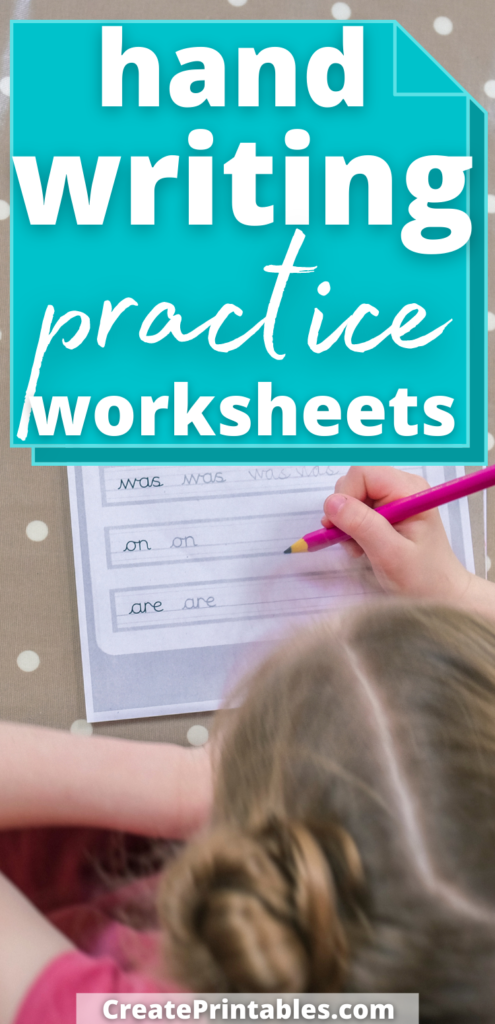Handwriting practice worksheets are a great way to get kids to learn, or improve, their writing skills. They’re especially handy in early elementary school when kids are old enough to sit down and write, but still developing their handwriting.
With more things becoming digital and typing takes over, it’s more important than ever to reinforce handwriting in kids. Even if it means working on it at home.

What Kind of Handwriting Practice Worksheets Are Best?
If you’re new to worksheets, here’s how to choose the best one for your child:
Age Appropriate
Look for printable worksheets that aren’t too easy or hard for the child who you’re practising with. There are handwriting practice worksheets that are great for beginners at the preschool or kindergarten level, and more advanced ones to help elementary aged kids.
It’s best if you start with skills they are already familiar with and work your way up to more difficult ones. If it’s too simple kids will get bored, and one that’s too complicated could lead to frustration.
Skill Building
What skills is the child working on that need some extra practice? Simple letter formation worksheets are great for beginners in preschool and kindergarten. Once they master their ABCs you can move on to whole words and phrases.
Another way to practice writing in elementary school is with guided lessons. You can incorporate teaching other skills, like learning the spelling of a child’s name, their address, or the days of the week into your writing practice to teach two skills at once!
Number Practice
Number formation is a part of handwriting and a necessary skill to develop as kids are introduced to early math concepts. Teaching kids to form, and later write, numbers 1-10, 1-20, and eventually 1-100 happens during kindergarten and the early elementary years.
Worksheets can help teach kids how to write their numbers and also give them number sense and rote counting practice.
Customizable
One size never fits all when it comes to kids. Choose printables that can be customized with your own words and fonts to help support a child’s learning goals. What’s great about custom options is that you can repeat the same worksheet at different difficulty levels or practice cursive handwriting.
Using Cursive Handwriting Practice Worksheets
Speaking of cursive, printables worksheets are one of the best ways to master that skill. Typically, kids start with basic printing and then move on to pre-handwriting letter formation. The D’Nealian – Manuscript font is great for this.
Since proper letter formation is really important with cursive writing (incorrect writing won’t flow as easily), handwriting practice worksheets should be repeated until kids get a good hang of each letter.
From there, you can move onto joining some letters together to spell a word. I like to start with the child’s name.
Using Worksheets to Measure Progress
If you’re an elementary school teacher or homeschooling family you’re always looking for ways to measure the child’s progress. Handwriting isn’t a black and white skill; it improves slowly over time.
So how do you measure handwriting progress?
At the beginning of the school year, have each child complete a handwriting worksheet. The exact worksheet you use will depend on the age of the kids. Kindergarteners and first grade kids, for example, should either use the alphabet or their name as a guide.
The school year will provide plenty of opportunities to develop any areas where kids might be struggling with their writing, and there’s definitely no shortage of writing practice for school aged kids!
At the end of the year have them repeat the worksheet they completed at the start. This will give you an idea of how much the child has improved with their writing over the term. Not only is it a great tool for educators, kids find seeing their progress motivating too.
For older elementary kids you can do something more complex. Just make sure that you can consistently repeat it again at the end of the year, or at least have them do something similar enough that you’ll be able to see the progress.
Measuring Numeracy Skills
You can also use this technique to measure number writing. For this, I really like the last page of this number tracing worksheet pack. You can use the other pages throughout the school year to practice, but the last one has numbers 1-100 listed on one page.
Just like with the handwriting worksheets, have kids complete the sheet at the start of the year to the best of their ability. You can also use those sheets as an indication for where your child or class is at, and tailor your lessons accordingly.
Then, at the end of the year, have them try and trace numbers 1-100 again and see how much they’ve improved!
Measuring Cursive Handwriting Progress
If your child is learning cursive handwriting, or you’re practising at home, you can use the same method to measure their progress with two worksheets.
When working with older children it’s nice to use a longer sentence when measuring cursive writing progress since it’s important to see how well the child can link the letters together.
If you want to see how well kids can write on their own, a printable creative story writing worksheet is a great way to encourage independent writing.
How to Use Worksheets to Improve Reading and Spelling
Writing out words is one of the best ways to help kids learn to spell. Customizable handwriting practice worksheets can be generated with a child’s name, dolch sight words, or weekly spelling words.
This word tracing worksheet is perfect for reading and spelling skills. You can customise it with any words or phrases you’re practising.
Rainbow Writing – Have them pick out several colored pencils and then write each letter out in a color pattern. This helps kids slow down and take in each letter because they have to stop to change colors.
Sound Blends – Use the worksheets to help identify tricky sound blends like \sh\ or \oo\. Have them write those blends in different colors or highlight them. This can also be helpful for kids with speech problems.
Rhyming Words – List a bunch of words that rhyme like “ball, fall, tall, hall, etc.” and have the child colour the rhyming part (all) in a different colour from the rest of the word. For older kids, use longer or compound words (eg. gumball, downfall, etc.).
Handwriting Worksheets for Language Learning
Whether it’s ESL or another language, worksheets are great for learning at any age. You can customise them to include vocabulary and spelling words. Then just use the techniques listed above to work on your reading or spelling!
How to Keep Children Interested in Handwriting Practice
When you’re working with kids at the early elementary level you have to get creative to keep them focused. Traditional worksheets are a great tool, but too much of them can get boring. Here’s some ways to make it more fun:
Emphasise Practising Their Name
It’s one of the first words young kids master writing. Planning writing practice around a child’s name is great for the start of kindergarten to introduce name writing, and throughout the year to practice other skills.
Name tracing practice booklets like this one can make writing more fun. There’s some tracing, plus cutting, sorting, and glueing activities. These break up the writing and help develop other early reading and writing skills in a more engaging way.
Think Past The Writing Worksheet
You can use worksheets for more than just writing! Some, like this playdough worksheet, are perfect for preschoolers to work on letter formation even if they can’t write yet.
Other ideas include turning a worksheet into a puzzle by cutting out each letter, using bubble letters to turn a worksheet into a word colouring page, and having kids use a worksheet as a reminder to help them write new words on a separate piece of paper.
You can also make worksheets fun by making them seasonal. Plus it’s a handy way to measure progress throughout the year.
Make it Useful
Learning is way more fun when you understand why you’re learning something. Instead of just having kids repeat letter formation or write out meaningless sentences, have them practice writing something they can actually use.
One way to do this is with an address writing worksheet. While it’s good for learning a child’s own address and phone number, you can also turn it into a letter writing activity.
First, collect and practice the address for someone the child would like to send a letter to. Then copy that address onto the envelope!
Since the post office will have to read the address, you’ll be able to give a real-world reason for why neat, legible handwriting is important to learn.
The letter itself can contain a drawing or, depending on the child’s age and skill level, it can be a letter – which is another opportunity to practice writing in a meaningful way.
Other Ways For Kids to Practice Handwriting
- Have them label their school work with their name, and later, the date.
- Encourage kids to write out useful information like family shopping lists.
- Writing little notes or messages inside of cards and giving them to family and friends.
- Gift lists for birthdays or holidays (letters to Santa are great for this!).
- Let kids practice with unique writing tools like window writers, sidewalk chalk, bath crayons, etc.
Handwriting practice worksheets are a great tool when it comes to teaching elementary aged kids printing and cursive writing! These activities are great for developing skills at home or in the classroom. Once your child gets used to worksheets, try adding in some fun activities to keep them interested. Have fun learning!

